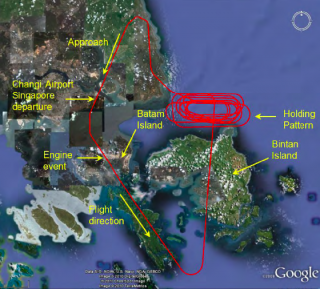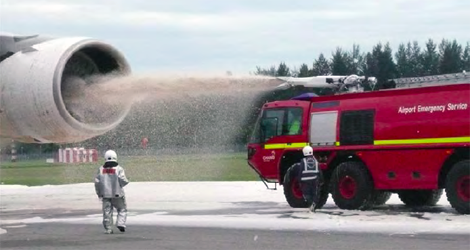
Engine of Qantas A380-842 (VH-OQA) flight QF32
Qantas flight QF32 departed Changi Airport, Singapore on a scheduled passenger flight to Sydney, Australia. About 4 minutes after take-off, while the aircraft was climbing through about 7,000 ft, the flight crew heard two ‘bangs’ and a number of warnings and cautions were displayed on the electronic centralised aircraft monitor (ECAM). Initially, the ECAM displayed a message warning of turbine overheat in the No. 2 (inner left) engine. That warning was followed soon after by a multitude of other messages relating to a number of aircraft system problems. After assessing the situation and completing a number of initial response actions, the flight crew were cleared by ATC to conduct a holding pattern to the east of Changi Airport. While in the holding pattern, the flight crew worked through the procedures relevant to the messages displayed by the ECAM. During that time the flight crew were assisted by additional crew that were on the flight deck as part of a check and training exercise.
The aircraft sustained significant impact damage to the left wing by fragments and debris from the UERF, and fuel was leaking from the damaged left wing fuel tanks. However, after completing the ECAM procedures and performing some aircraft controllability checks, the flight crew landed the aircraft safely at Changi Airport.

flight path of Qantas – A380-842 (VH-OQA) flight QF32
After landing, fuel continued to leak from the left wing tank. The risk associated with this leak was minimised by the airport emergency services by applying large quantities of water and foam below the left wing while the aircraft’s engines were shut down.
The No. 1 (outer left) engine continued to run following the normal shut-down procedure. Because of the still-running engine and leaking fuel on the left side, the passengers were disembarked via a set of stairs on the right side of the aircraft. The disembarkation was completed about 2 hours after the aircraft landed. Numerous unsuccessful attempts to shut down the No. 1 engine were made by the flight crew, maintenance engineers and the airport emergency services using different methods . The engine was finally shut down about 3 hours after the aircraft landed by pumping firefighting foam directly into the engine inlet.
Over time, a fatigue crack had developed in the thin-wall section of the oil feed stub pipe in the No. 2 engine to the extent that, during the occurrence flight, opening of the crack through normal movement within the engine released oil into the HP/IP buffer space.
• Auto-ignition of the oil leaking from the oil feed stub pipe created an intense and sustained fire within the HP/IP buffer space that resulted in localised heat damage to the intermediate pressure (IP) turbine disc.
• The IP turbine disc separated from the drive arm and accelerated.
• Following the separation of the IP turbine disc from the drive arm, the engine behaved in a manner that differed from the engine manufacturer’s modelling and experience with other engines in the Trent family, with the result that the IP turbine disc accelerated to a rotational speed in excess of its design capacity whereupon it burst in a hazardous manner.
Download Report


0 Comments